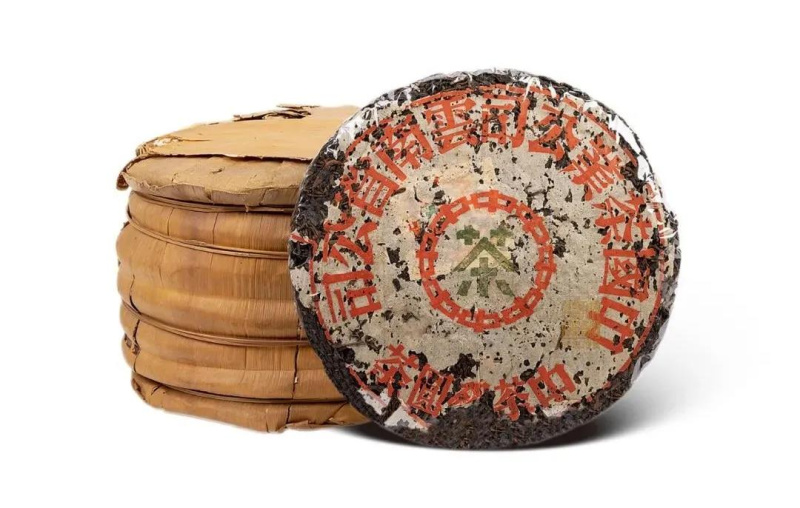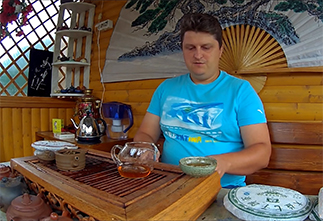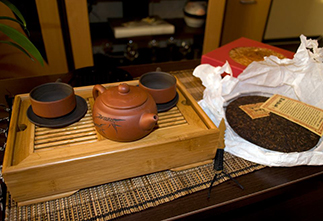Shu Puer 2007 "Xiaguan Tuocha" brand "Pine and Crane": Classic Chinese tea
Shu Puer 2007 "Xiaguan Tuocha" brand "Pine and Crane" is an exquisite Chinese tea produced at the famous factory "Xiaguan" in Yunnan Province. This tea belongs to the category of shu puers, which undergo an accelerated fermentation process. It is pressed in the form of a nest and weighs 250 grams.
Description of tea
- Growing region: Yunnan, China
- Manufacturer: Xiaguan Plant
- Variety: Shu Puer
- Press form: Nest
- Weight: 250 grams
- Year of production: 2007
Taste and aroma
Shu Puer 2007 "Xiaguan Tuocha" brand "Pine and Crane" has a characteristic sweet, nutty taste and aroma of earth and raw wood. In its bouquet you can find notes of:
- Dried fruits: dates, prunes, figs
- Nuts: walnuts, pine nuts
- Chocolate
- Lands
- Raw wood
The aroma is rich and multifaceted. You can detect shades of dried fruits, nuts, earth and spices.
Health benefits
Shu puer, like other types of puer, has many beneficial properties:
- Improved digestion: Promotes normal functioning of the gastrointestinal tract.
- Antioxidant properties: Protects the body's cells from the harmful effects of free radicals.
- Tonic effect: Increases energy levels and improves concentration.
- Lowering cholesterol levels
- Improving the functioning of the cardiovascular system
How to brew
For brewing shu puer, it is recommended to use water at a temperature of 95-100°C. The tea can be brewed in a gaiwan or a teapot. The first brewing usually takes 15-20 seconds, the subsequent ones - longer.
Why choose this tea?
- High quality: Shu puer 2007 "Xiaguan Tuocha" brand "Pine and Crane" is a classic Chinese tea. It has excellent organoleptic properties and many years of aging.
- Unique Taste: This tea has a deep and complex flavor that will appeal to many tea connoisseurs.
- Health benefits: Shu puer has many health benefits.
- Collector's Value: This tea would make a great addition to your Chinese tea collection.
Shu puer 2007 "Xiaguan Tuocha" brand "Pine and Crane" is a real masterpiece of Chinese tea art. Its deep taste, rich aroma and useful properties make it an ideal choice for connoisseurs of quality tea.
|
Name in Chinese
|
2007年下關沱茶(集團)股份有限公司熟沱茶(盒裝250克) |
|
Pinyin
|
2007 Nián xia guān tuóchá (jítuán) gǔfèn yǒuxiàn gōngsī shú tuóchá (hé zhuāng 250 kè) |
|
Country
|
China |
|
Provinces
|
Yunnan (云南) |
|
Manufacturer
|
Сягуань (云南下关沱茶集团) |
|
Raw material production date
|
2007/03/05 |
|
Year of pressing
|
2007 |
|
Pressing form
|
Tuo Cha (Tuo Tea) |
- Комментарии
- Вконтакте
Pu-erh is one of the most unique types of tea, which only gets better with age. Many people, when they first encounter this tea, wondered: why is pu-erh more often found in pressed form (cakes, bricks, tochas), and not in loose form? The reasons for this are related to both history and the practical aspects of storing and fermenting tea. Despite modern technologies that allow the production of loose pu-erh, the shape of pressed cakes remains unchanged. And pu-erh is more often found on sale in pressed form, for example, in the form of cakes or bricks, and loose pu-erh is less common. We will talk about the reasons for pressing pu-erh into cakes in this article.
Puer is a unique Chinese tea that is distinguished by its depth of taste, complexity of aromas and versatility of aftertaste. Its taste characteristics are formed under the influence of many factors, from growing conditions to the brewing method. Let's look at the main ones.
The question often arises: how to brew puerh correctly? Sometimes the phrase "to get high" is added to it. Moreover, everyone has their own understanding of this phrase. Some mean vigor, and some - intoxication. So how to brew puerh tea correctly? Let's consider several options.
Traveling through the tea mountains, we found ourselves in another land of blue roofs - the village of Zhongcai, which is located in the Menghai district of Yunnan province. According to tradition, we were shown another local tea tree, which, according to the Chinese, is at least a million years old :) The village is very authentic, not designed for tourists, there are many wild pu-erhs there and, of course, we were warmly received. They treated us to local cuisine and tea. We also asked the residents about the prices of tea and how they have changed in recent years.
The tea ceremony occupies a special place in the centuries-old Eastern tradition. And although the essence of this phenomenon remains constant, the nature and external manifestations of the tea ceremony in different nations have their own national characteristics. In each Chinese province, the tea ceremony and the tea used in it are varied: for example, residents of the southern provinces prefer green tea, and residents of the northern provinces - red tea, in Fujian province they more often use Oolong tea, and in Yunnan province Puer tea is widely known.


























































































